The Interlock Vials Market is estimated to be valued at USD 8.7 billion in 2025 and is projected to reach USD 14.6 billion by 2035, registering a compound annual growth rate (CAGR) of 5.3% over the forecast period.
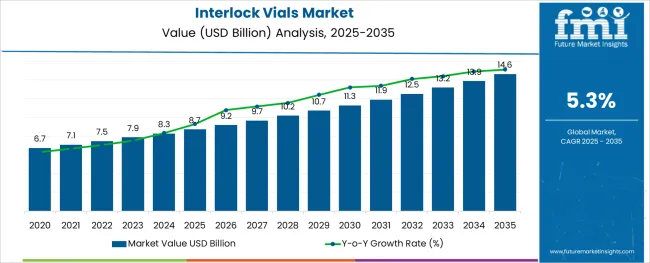
The interlock vials market is witnessing consistent growth driven by the rising emphasis on contamination-free sample handling, analytical accuracy, and compatibility with automated systems in laboratories and pharmaceutical research.
These vials are gaining widespread adoption across chromatography, forensic testing, clinical diagnostics, and high-precision R&D workflows due to their secure fit and minimal dead volume. Industry participants are prioritizing chemically inert materials and advanced insert technologies that support sample integrity and traceability.
Additionally, increased deployment of autosamplers and robotic dispensing systems in regulated lab environments is influencing vial design preferences that ensure consistent injection reliability and minimal sample loss. Demand is also being supported by expanding pharmaceutical pipelines, stringent validation requirements, and the global push toward laboratory standardization. As laboratories modernize their infrastructure, the focus is shifting toward durable, cleanroom-compatible, and precision-engineered vial solutions, which is expected to further propel market penetration and innovation in vial configurations.
The market is segmented by Insert Type, Material Type, and Cap Type and region. By Insert Type, the market is divided into Shell Style Inserts, Glass Inserts with Bottom Springs, and Glass Inserts with Top Springs. In terms of Material Type, the market is classified into Borosilicate Glass and Type 1 Glass. Based on Cap Type, the market is segmented into Screw Top Interlock Vials and Crimp Top Interlock Vials. Regionally, the market is classified into North America, Latin America, Western Europe, Eastern Europe, Balkan & Baltic Countries, Russia & Belarus, Central Asia, East Asia, South Asia & Pacific, and the Middle East & Africa.
The market is segmented by Insert Type, Material Type, and Cap Type and region. By Insert Type, the market is divided into Shell Style Inserts, Glass Inserts with Bottom Springs, and Glass Inserts with Top Springs. In terms of Material Type, the market is classified into Borosilicate Glass and Type 1 Glass. Based on Cap Type, the market is segmented into Screw Top Interlock Vials and Crimp Top Interlock Vials. Regionally, the market is classified into North America, Latin America, Western Europe, Eastern Europe, Balkan & Baltic Countries, Russia & Belarus, Central Asia, East Asia, South Asia & Pacific, and the Middle East & Africa.
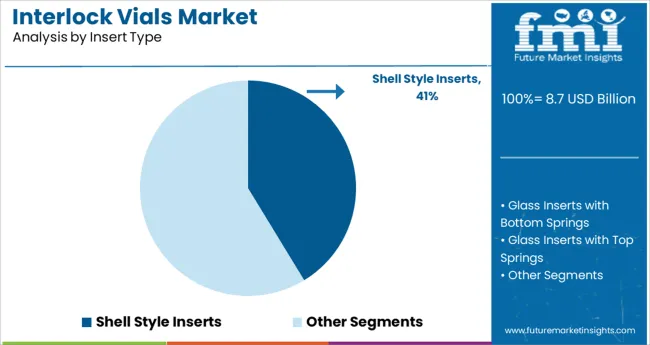
Shell style inserts are anticipated to hold a 41.3% revenue share in the interlock vials market in 2025, making them the leading subsegment under insert type. Their dominance is attributed to the enhanced sample containment and structural support they provide, which improves stability during injection and prevents cross-contamination.
These inserts are preferred in high-precision analytical procedures due to their ability to reduce sample evaporation and accommodate low-volume applications effectively. Laboratories adopting sensitive techniques such as LC-MS and GC-MS have increasingly integrated shell style inserts to ensure optimal sample recovery and cleanliness.
Their compatibility with a wide range of vial sizes and autosampler systems has further reinforced their share. Additionally, manufacturers have introduced variants with graduated markings and pre-assembled options, simplifying lab operations and supporting continued growth of this segment.
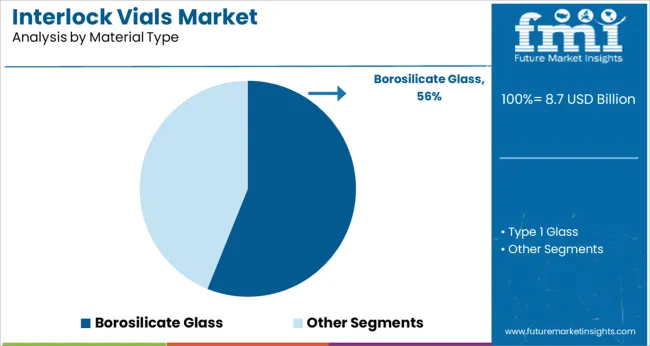
Borosilicate glass is projected to account for 56.1% of the total revenue in 2025 under the material type category, maintaining its leadership due to its superior chemical resistance, thermal stability, and minimal extractables.
The material’s inert properties ensure that sample composition remains unaffected during storage and testing, making it the preferred choice in pharmaceutical and analytical labs. Its ability to withstand high autoclave temperatures and prevent leaching of contaminants aligns with regulatory expectations in GMP-compliant environments.
Laboratories handling volatile solvents or bioactive compounds have increasingly adopted borosilicate vials for their reliability and durability. The expanding use of interlock vials in stability testing, toxicology, and pharmacokinetic studies has further elevated demand for borosilicate glass. The availability of precision-molded formats and seamless integration into automated workflows has cemented its position as the material of choice across global laboratory networks.
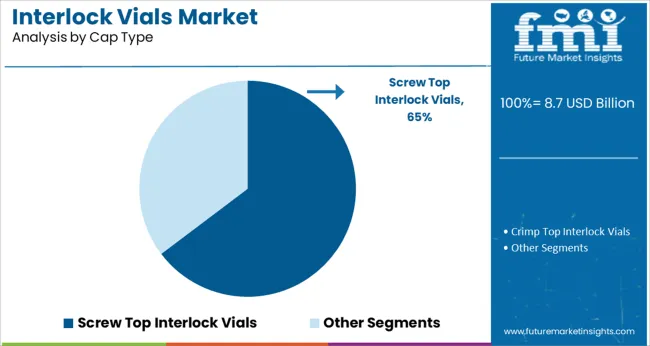
Screw top interlock vials are projected to hold 64.7% of the revenue share under the cap type segment in 2025, establishing themselves as the preferred choice in this category. Their popularity is driven by ease of handling, secure sealing, and compatibility with automation systems.
The screw closure mechanism ensures leak-proof performance during sample transport and processing, which is essential in high-throughput laboratories and field collection applications. Users favor screw top formats for their resealability, tamper evidence, and reduced risk of contamination during repeated access.
These vials are widely adopted in pharmaceutical, chemical, and environmental labs where repeated sampling or long-term storage is required. With growing demand for productivity and data reliability, manufacturers have enhanced screw top designs with color-coded caps, septa options, and sterilization compatibility, strengthening their dominance in the interlock vials market.
The global interlock vials market represents manufacturers supplying amber or clear interlock vials. Interlock vials are made up of materials such as Type 1 glass and borosilicate glass. Glass vial manufacturers predominantly define the dynamics of the global market for interlock vials.
The global interlock vials market serves a widespread client base operating in the global healthcare industry. Effective functionality of interlock vials due to the design properties of these vials and design has allowed pharmaceutical and healthcare companies to deliver various products in convenient storage and retrieval systems.
Maximum sales of Interlock vials are contributed by laboratories as an ideal solution for sampling applications where sample volume is limited. As these also offer minimal sample loss due to spillage and maximum sample extraction, the demand for interlock vials is more.
Micro-volume inserts are designed to work at volume capacities of 1 ml, 2 ml, and 3 ml. The interlock vials find application in chromatography and storage of samples in pathology, contributing immensely to the interlock vials market share globally.
There are various advantages associated with it, such as having excellent chemical resistance, and the conical interior design eliminates time consumption during the assembly of inserts and vials. These are designed for maximum and easy retrieval of contents making the sales of interlock vials to the medical research segment the main target for manufacturers.
Manufacturers offer inserts that are compatible with a specific volume of vials and flat bottom inserts and are economical, resulting in higher demand for interlock vials for limited sampling.
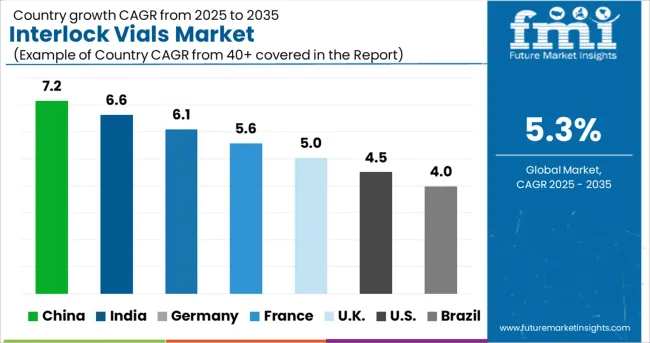
Geographically, the global interlock vials market has been divided into seven key regions; North America, Latin America, Europe, East Asia, South Asia, Middle East & Africa, and Oceania. North America is anticipated to be the prominent region for the sales of interlock vials due to the well-established healthcare market in the region.
The healthcare market is well-developed in The United States. The unequaled sales of interlock vials are rising as the awareness regarding their health benefits is increasing. The demand for Interlock vials is high as these are used to reduce the risks of contamination. The interlock vials market share is anticipated to have a positive outlook during the forecast period.
Pharmaceutical packaging manufacturers can have the opportunity to tap the demand for interlock vials in the emerging economies in the Asia Pacific market for substantial growth.
A growing number of pharmaceutical companies across the countries is expected to create a huge market for the sales of interlock vials in the Asia Pacific region. The other geographical regions of Latin America and Europe are also expected to contribute significantly to the interlock vials market share with the growth of pharmaceutical companies as well.
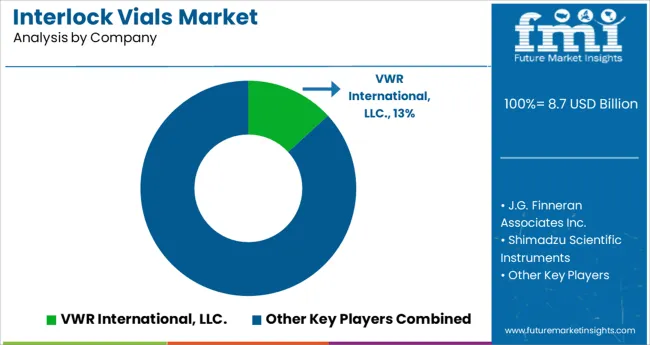
Two prominent names among the several manufacturers operating in the global interlock vials market are Restek Corporation and J.G. Finneran Associates Inc.
Most of the manufacturers are present in the Asia Pacific countries such as China and India as a majority of demand for Interlock vials comes from the pharmaceutical companies established in these regions. A number of new players have also emerged in these regions owing to the growing demand for interlock vials by the expansion of pharmaceutical manufacturing companies.
Some of the Recent Developments in the Interlock Vials Market
| Report Attribute | Details |
|---|---|
| Growth Rate | CAGR of 5.3% from 2025 to 2035 |
| Base Year of Estimation | 2024 |
| Historical Data | 2014 to 2024 |
| Forecast Period | 2025 to 2035 |
| Quantitative Units | Revenue in million and CAGR from 2025 to 2035 |
| Report Coverage | Revenue Forecast, Volume Forecast, Company Ranking, Competitive Landscape, Growth Factors, Trends, and Pricing Analysis |
| Segments Covered | Insert Type, Material Type, Cap Type, Region |
| Regions Covered | North America; Latin America; Western Europe; Eastern Europe; Asia-Pacific excluding Japan; Japan; Middle East and Africa |
| Key Countries Profiled | United States of America, Canada, Brazil, Argentina, Germany, United Kingdom, France, Spain, Italy, Nordics, BENELUX, Australia & New Zealand, China, India, ASIAN, GCC Countries, South Africa |
| Key Companies Profiled |
Restek Corporation; J.G. Finneran Associates Inc. |
| Customization scope | Available Upon Request |
| Pricing and Purchase Option | Avail of Customized purchase options to meet your exact research needs. |
The global interlock vials market is estimated to be valued at USD 8.7 billion in 2025.
It is projected to reach USD 14.6 billion by 2035.
The market is expected to grow at a 5.3% CAGR between 2025 and 2035.
The key product types are shell style inserts, glass inserts with bottom springs and glass inserts with top springs.
borosilicate glass segment is expected to dominate with a 56.1% industry share in 2025.






Our Research Products

The "Full Research Suite" delivers actionable market intel, deep dives on markets or technologies, so clients act faster, cut risk, and unlock growth.

The Leaderboard benchmarks and ranks top vendors, classifying them as Established Leaders, Leading Challengers, or Disruptors & Challengers.

Locates where complements amplify value and substitutes erode it, forecasting net impact by horizon

We deliver granular, decision-grade intel: market sizing, 5-year forecasts, pricing, adoption, usage, revenue, and operational KPIs—plus competitor tracking, regulation, and value chains—across 60 countries broadly.

Spot the shifts before they hit your P&L. We track inflection points, adoption curves, pricing moves, and ecosystem plays to show where demand is heading, why it is changing, and what to do next across high-growth markets and disruptive tech

Real-time reads of user behavior. We track shifting priorities, perceptions of today’s and next-gen services, and provider experience, then pace how fast tech moves from trial to adoption, blending buyer, consumer, and channel inputs with social signals (#WhySwitch, #UX).

Partner with our analyst team to build a custom report designed around your business priorities. From analysing market trends to assessing competitors or crafting bespoke datasets, we tailor insights to your needs.
Supplier Intelligence
Discovery & Profiling
Capacity & Footprint
Performance & Risk
Compliance & Governance
Commercial Readiness
Who Supplies Whom
Scorecards & Shortlists
Playbooks & Docs
Category Intelligence
Definition & Scope
Demand & Use Cases
Cost Drivers
Market Structure
Supply Chain Map
Trade & Policy
Operating Norms
Deliverables
Buyer Intelligence
Account Basics
Spend & Scope
Procurement Model
Vendor Requirements
Terms & Policies
Entry Strategy
Pain Points & Triggers
Outputs
Pricing Analysis
Benchmarks
Trends
Should-Cost
Indexation
Landed Cost
Commercial Terms
Deliverables
Brand Analysis
Positioning & Value Prop
Share & Presence
Customer Evidence
Go-to-Market
Digital & Reputation
Compliance & Trust
KPIs & Gaps
Outputs
Full Research Suite comprises of:
Market outlook & trends analysis
Interviews & case studies
Strategic recommendations
Vendor profiles & capabilities analysis
5-year forecasts
8 regions and 60+ country-level data splits
Market segment data splits
12 months of continuous data updates
DELIVERED AS:
PDF EXCEL ONLINE
Market Share Distribution Among Interlock Vials Manufacturers
Interlocked Armored Cable Market Size and Share Forecast Outlook 2025 to 2035
Interlocking Boxes Market Growth & Forecast 2025 to 2035
Leading Providers & Market Share in Interlocking Boxes
Safety Interlock Switches Market Analysis by Actuation Method, Application and End-use Industry and Region 2025 to 2035
Automotive Key Interlock Cable Market Forecast & Analysis for 2025 to 2035
Micro Vials Market Size and Share Forecast Outlook 2025 to 2035
Serum Vials Market Size and Share Forecast Outlook 2025 to 2035
Shell Vials Market Size and Share Forecast Outlook 2025 to 2035
Plastic Vials and Ampoules Market Size and Share Forecast Outlook 2025 to 2035
Polymer Vials Market Insights & Industry Growth 2025 to 2035
Leading Providers & Market Share in Plastic Vials and Ampoules Industry
Flip Top Vials Market Size and Share Forecast Outlook 2025 to 2035
Formalin Vials Market Size and Share Forecast Outlook 2025 to 2035
Cosmetic Vials Market Trends - Size & Growth 2025 to 2035
Snap Cap Vials Market
Cryogenic Vials and Tubes Market Size and Share Forecast Outlook 2025 to 2035
Diagnostic Vials Market Size and Share Forecast Outlook 2025 to 2035
Breaking Down Diagnostic Vials Market Share & Industry Insights
Speciality Vials Market

Thank you!
You will receive an email from our Business Development Manager. Please be sure to check your SPAM/JUNK folder too.
Chat With
MaRIA